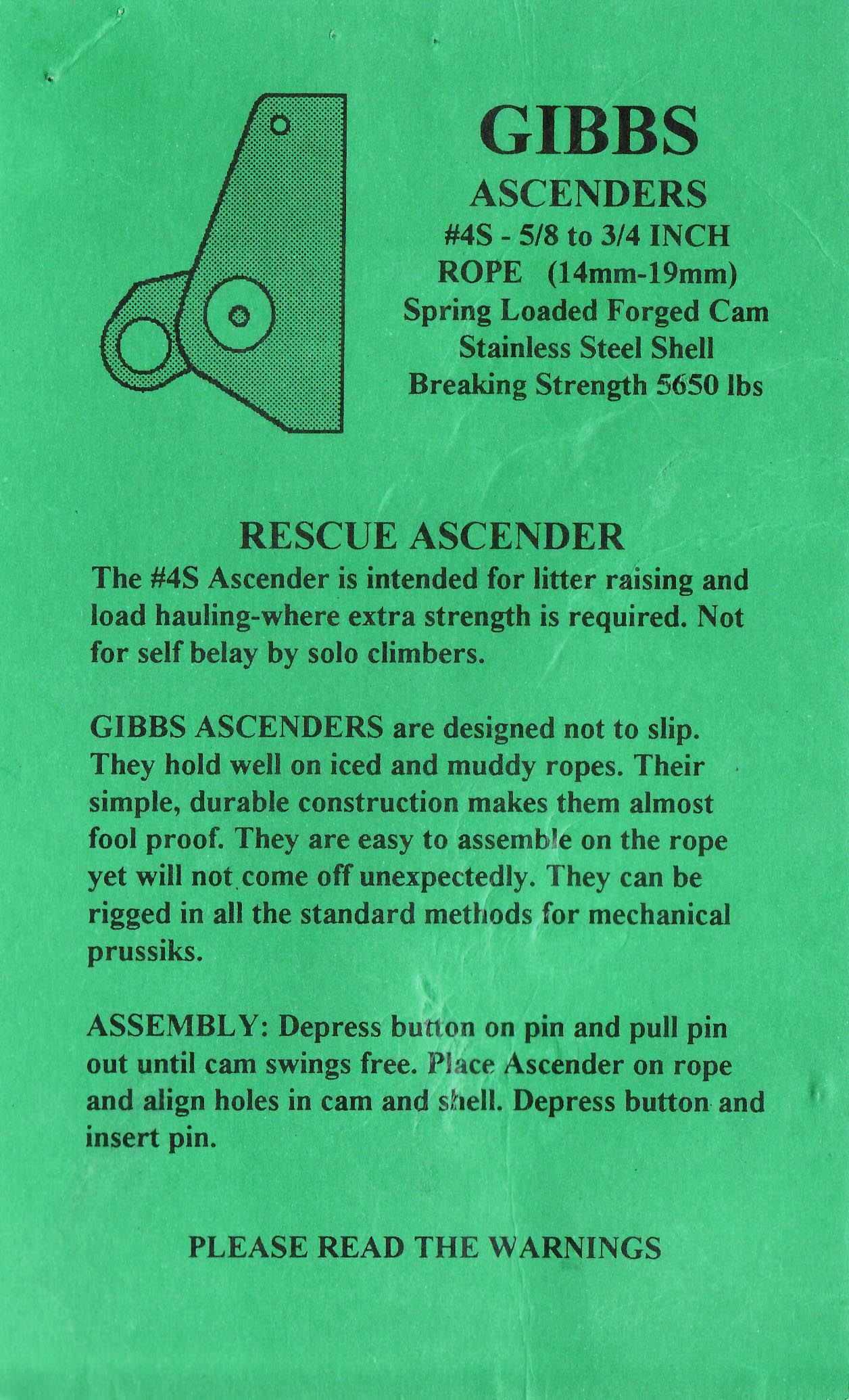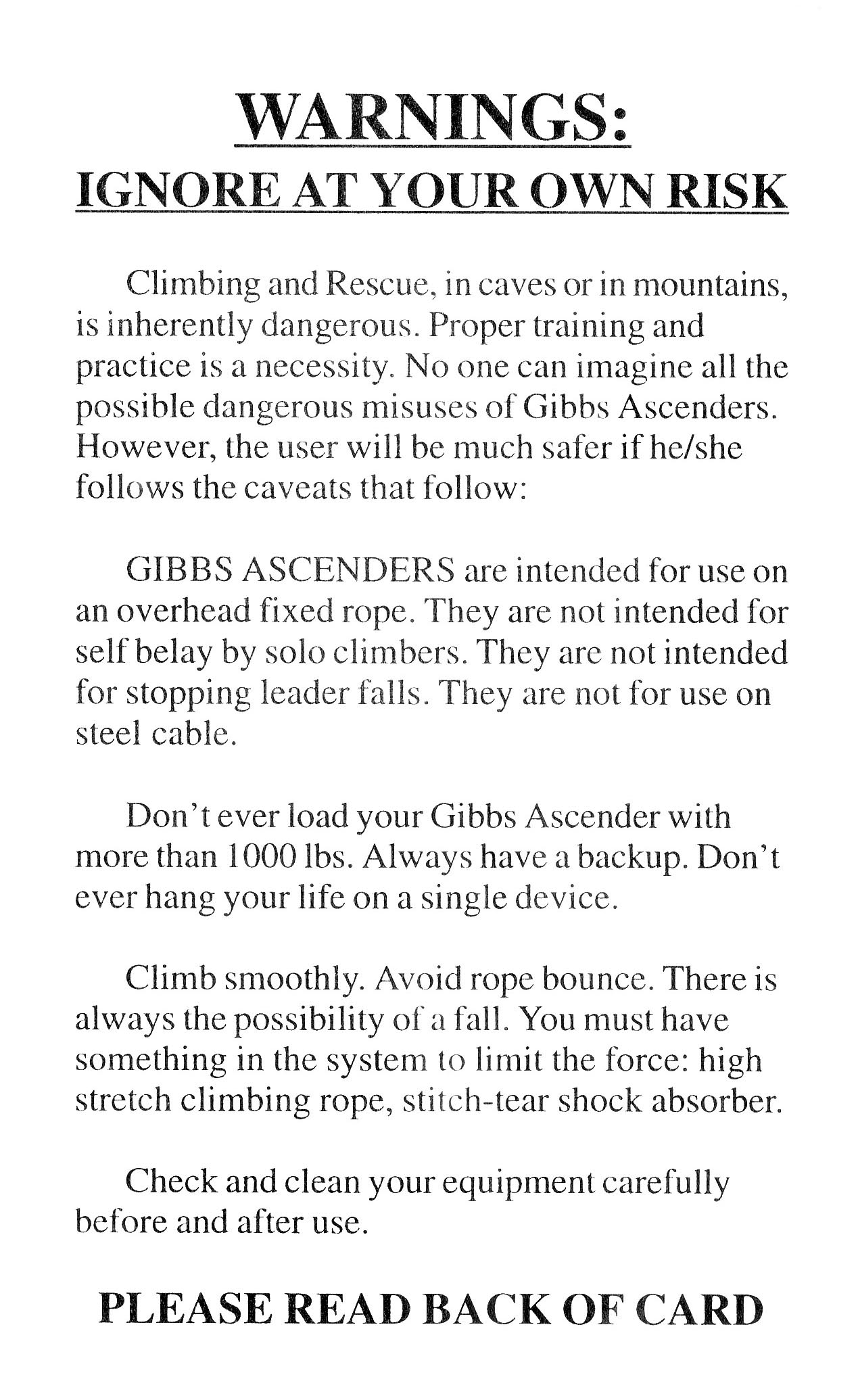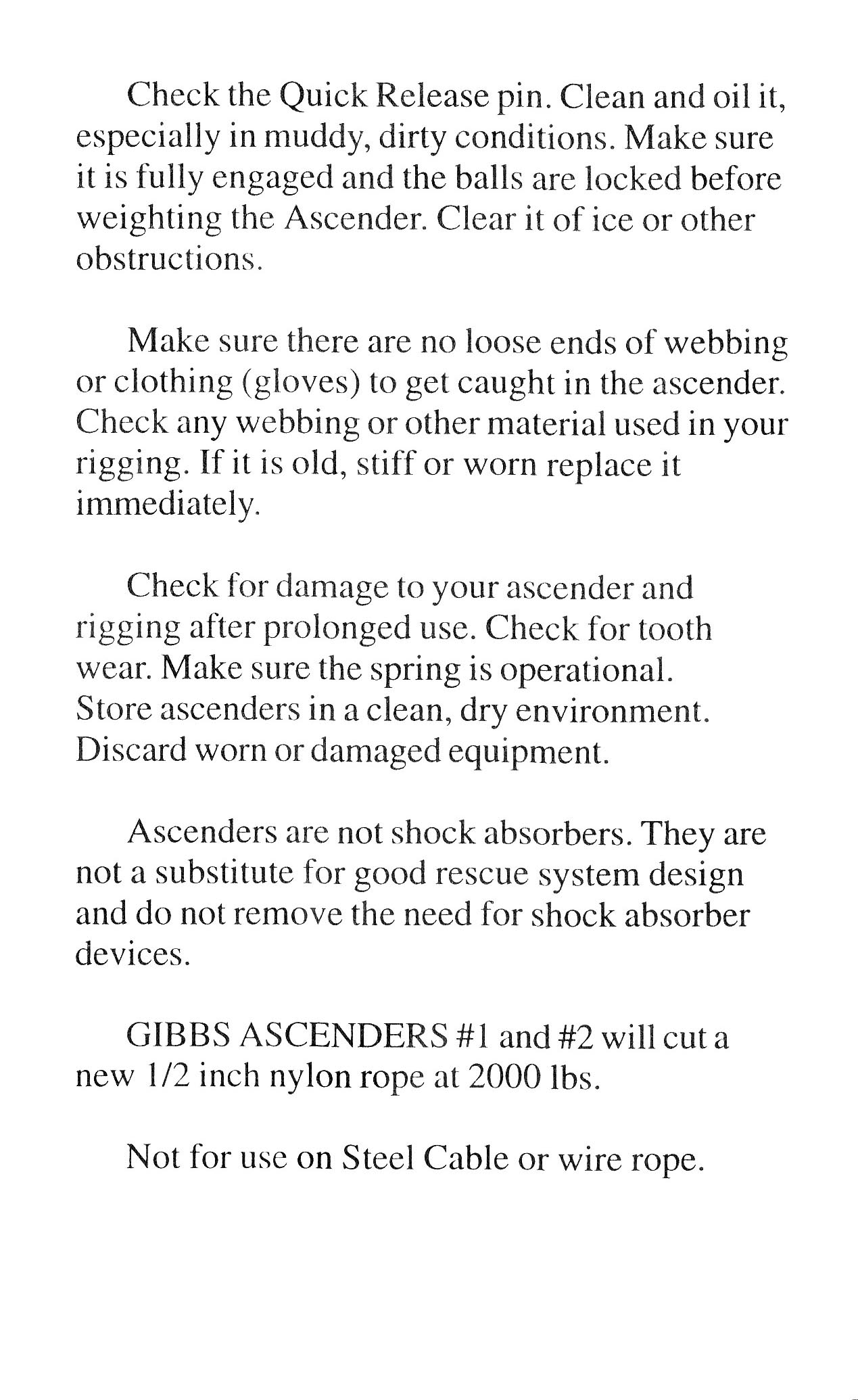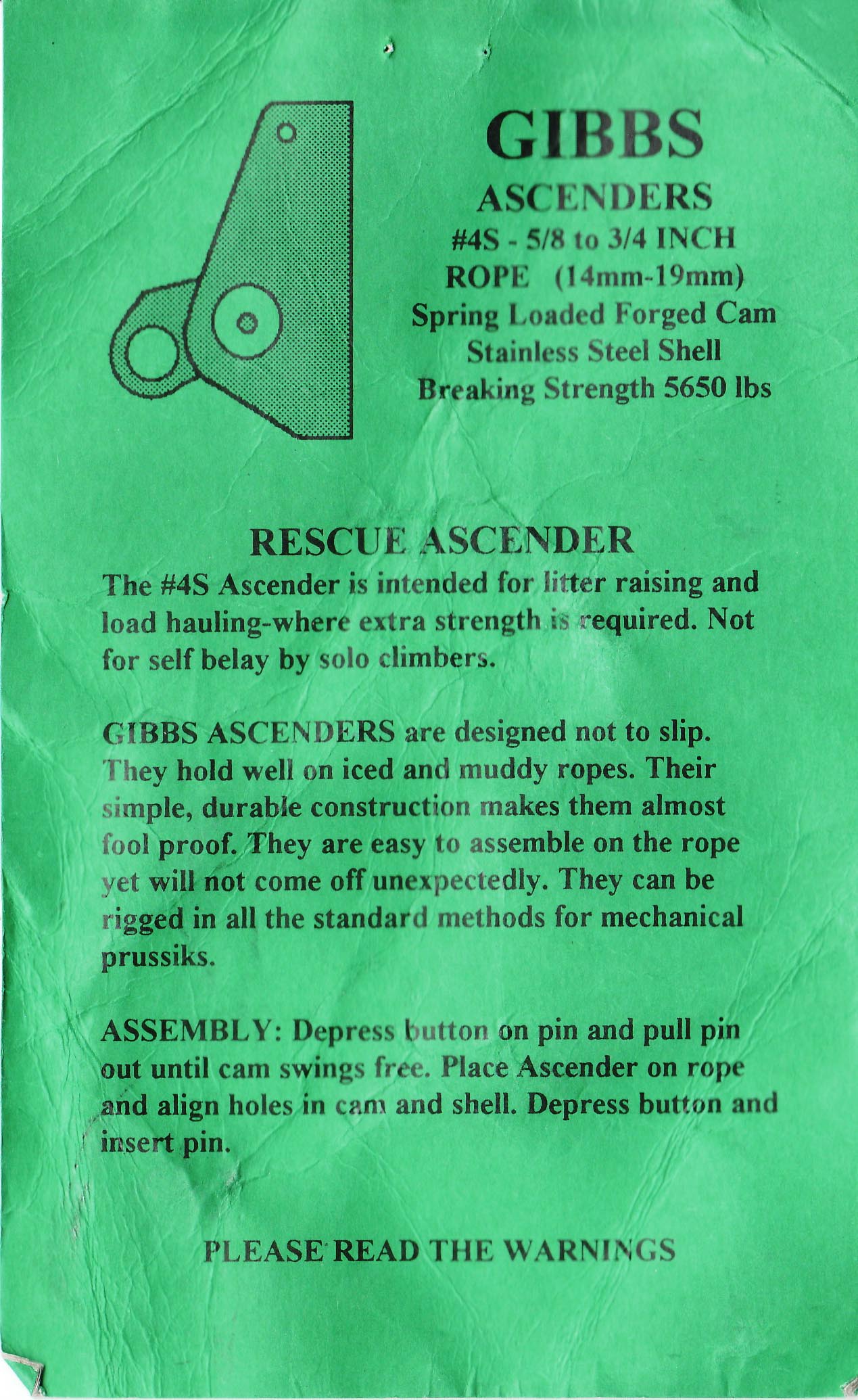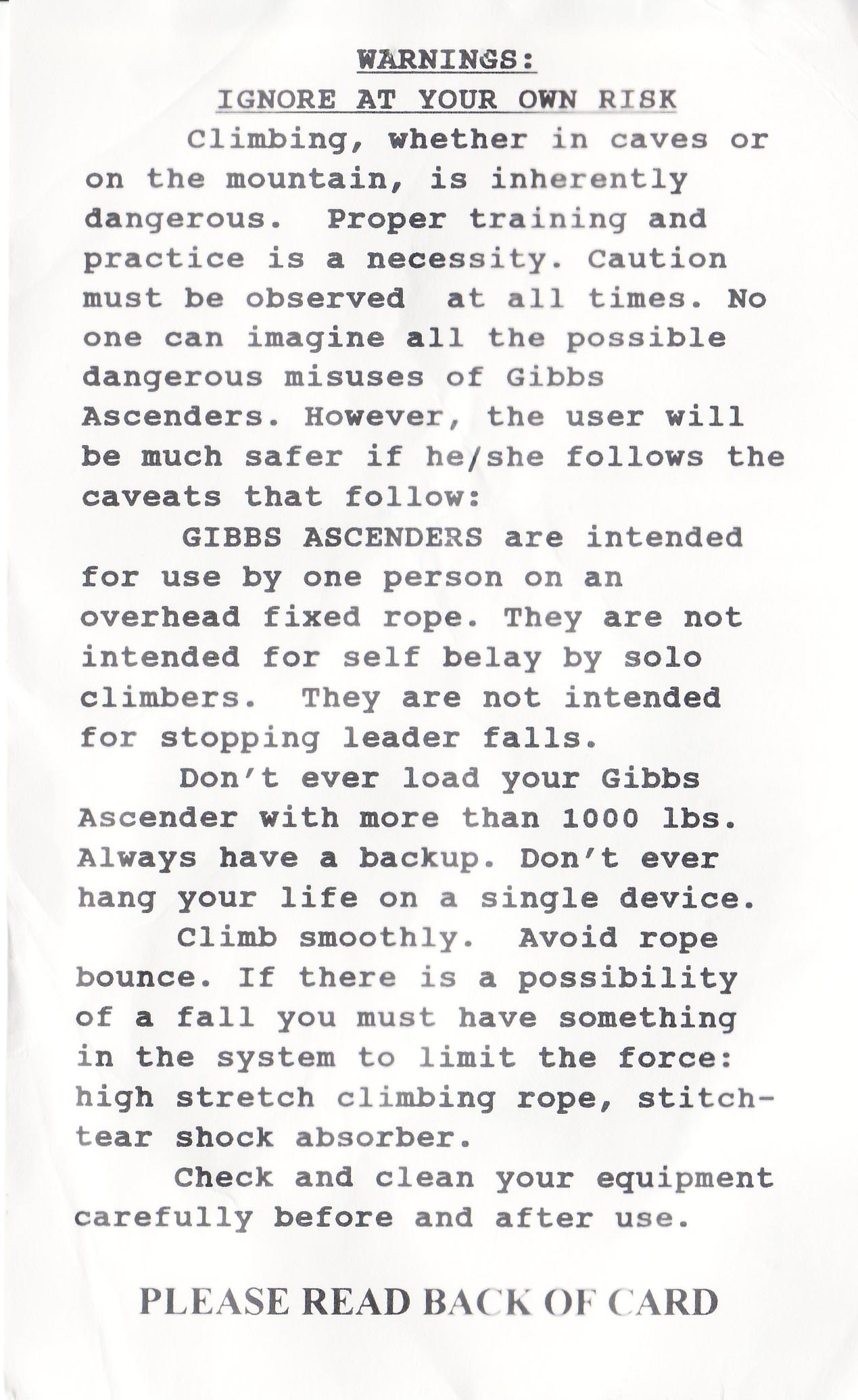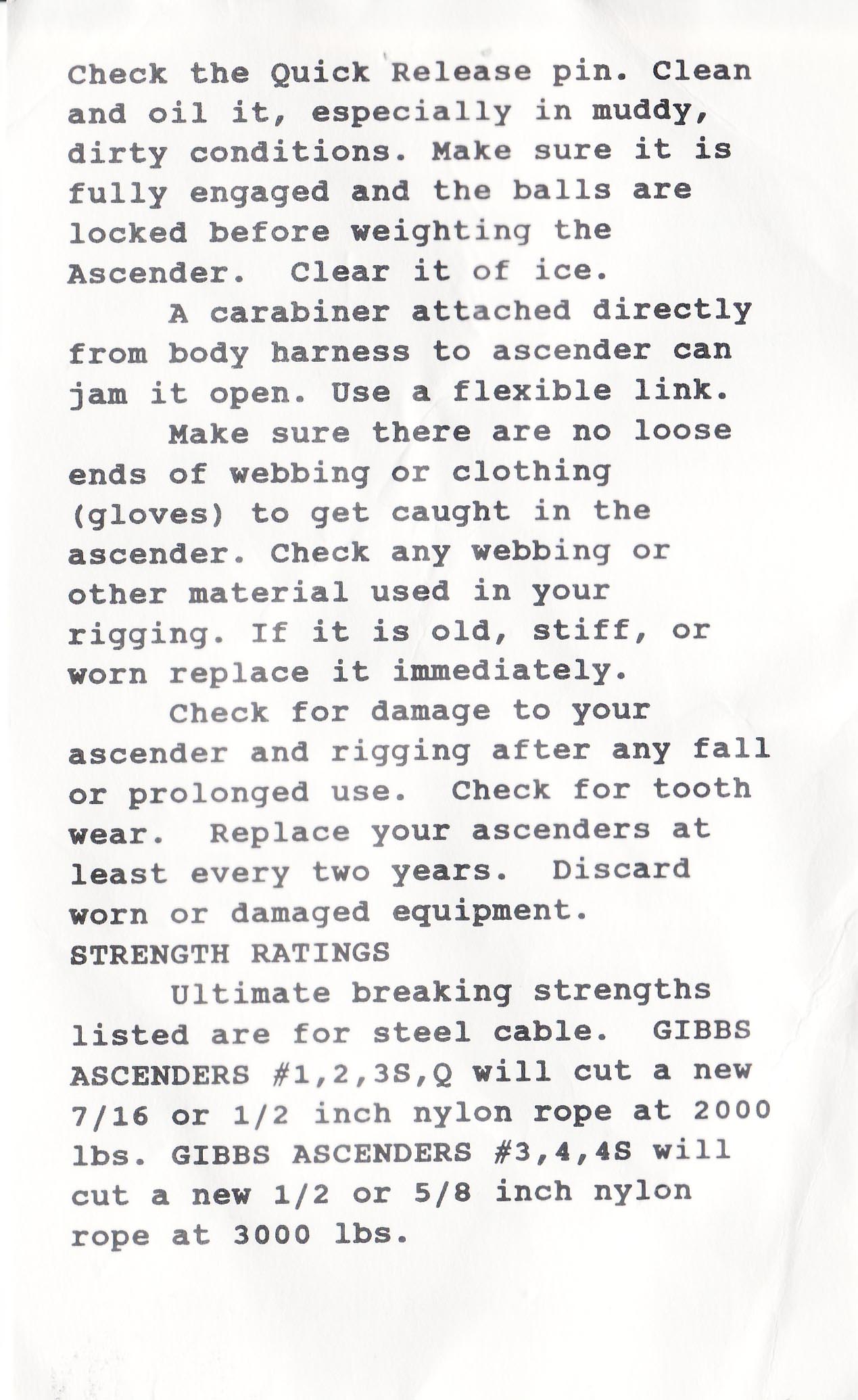Overview
[ Top
| 3/4" SS Ver. B
| 3/4" SS Ver. C
| #4S Ver. A
| #4S Ver. B
| #4S Ver. C
| Return to L.C. Ascenders
]
3/4" Stainless Steel, Version A
(#76)
Technical Details
I acquired my Gibbs QR, Stainless Steel, Version A from John E. Weinel, Inc. in 1989.
Version A is 105 mm. tall, 81 mm. wide, 76 mm. thick, and weighs 500 g.
The 3/4" aluminum-shelled ascenders weighed less than
a pound each. Gibbs introduced this stainless steel shell version,
which breaks the pound barrier.
[ Top
| 3/4" SS Ver. A
| 3/4" SS Ver. C
| #4S Ver. A
| #4S Ver. B
| #4S Ver. C
| Return to L.C. Ascenders
]
3/4" Stainless Steel, Version B
(#2316)
Technical Details
I acquired my Gibbs (3/4) QR, Stainless Steel, Version B from On Rope 1 at the 2017 NSS Convention. It was new old stock from Bob & Bob’s going-out-of-business liquidation.
The Gibbs (3/4) QR, Stainless Steel, Version B is 105 mm. tall, 83 mm. wide, 75 mm. thick, and weighs 506 g. The rope channel is 23 mm. wide. The cam is cast aluminum. The cam radius increases from 25 to 41 mm. over an angle of 79°, giving a 20° cam angle. The QR pin is 12.4 mm. in diameter. A tear-drop metal piece riveted to the shell holds a cable keeper for the QR pin and a webbing cam keeper.
Each side of the shell is stamped with "UP," an up-pointing arrow, and "GIBBS" with a double underline. The QR pin is stamped with "AVIBANK PUSH," and "BLS8B13SL5."
This version moves the teardrop lower on the shell.
[ Top
| 3/4" SS Ver. A
| 3/4" SS Ver. B
| #4S Ver. A
| #4S Ver. B
| #4S Ver. C
| Return to L.C. Ascenders
]
3/4" Stainless Steel, Version C
(#1920)
Technical Details
I acquired my Gibbs (3/4) QR, Stainless Steel, Version C as new old stock from Speleoshoppe in 2012.
Version C is 107 mm. tall, 83 mm. wide, 75 mm. thick, and weighs 505 g. The rope channel is 23 mm. wide. The cam is cast aluminum. The cam radius increases from 23 to 37 mm. over an angle of 92°, giving a 17° cam angle. The QR pin is 12.4 mm. in diameter. The cam is spring-loaded with a coil spring that is attached to the cam with a phillips-head screw. The other end has a split ring that can be placed over a tab pressed out of the shell. A chain on the split ring provides for a better grip. A tear-drop metal piece riveted to the shell holds a cable keeper for the QR pin and a second chain to the split ring.
This Gibbs is larger than necessary, requires impractically large ropes, and is too heavy for normal caving or climbing use. Huge, heavy, spring loaded, and a pin keeper that makes opeining the ascender rather awkward. What can I say? This ascender does not fit my needs.
[ Top
| 3/4" SS Ver. A
| 3/4" SS Ver. B
| 3/4" SS Ver. C
| #4S Ver. B
| #4S Ver. C
| Return to L.C. Ascenders
]
 #4S, Version A
#4S, Version A
(#143)
Technical Details
I acquired my Gibbs #4S, Version A from John E. Weinel, Inc., 1999.
The Gibbs #4S, Version A is 105 mm. tall, 91 mm. wide, 64 mm. thick, and weighs 438 g. The design was refined by going to a dimpled shell, wire spring,
forged cam (complete with goo) and stainless steel quick-release
pin.
Each side of the shell is stamped with "UP," an up-pointing arrow, and "GIBBS" with a double underline. The QR pin is stamped with "LOCKWELL," "PUSH," "HARTWELL-LA.-U.S.A.," and "62060/L66CB1125."
The cam is covered with goo. Yuck! For use as an ascender, this is totally
absurd, all that happens is that the goo eventually rubs off.
If you don't like it, a little time with a penknife gets rid of
it all. Supposedly the goo helps the cam slip if you abuse the
ascender by dropping loads on it (at least the first time, then the goo is gone). I don't do that so I don't care.
This Gibbs is larger than necessary, requires impractically large ropes, and is too heavy for normal caving or climbing use. The result came in just under a pound. Enough
said. Lemon  .
.
[ Top
| 3/4" SS Ver. A
| 3/4" SS Ver. B
| 3/4" SS Ver. C
| #4S Ver. A
| #4S Ver. C
| Return to L.C. Ascenders
]
#4S, Version B
(#274)
Technical Details
I acquired my Gibbs #4S, Version B from On Rope 1 in 2009.
The Gibbs #4S, Version B is 104 mm. tall, 87 mm. wide, 64 mm. thick, and weighs 425 g. The shell is made from 3.1 mm. aluminum sheet and has two dimples opposite the cam face. The cam is cast from aluminum alloy. The QR pin is 9.3 mm. in diameter. The cam is spring-loaded with a wire spring that sits in a plastic housing. A piece of webbing riveted to the spring housing acts as a keeper for the QR pin.
Each side of the shell is stamped with "UP," an up-pointing arrow, and "GIBBS" with a double underline. The QR pin is stamped with "LOCKWELL," "PUSH," "HARTWELL-LA.-U.S.A.," and "62060/L66CB1125."
This Gibbs is larger than necessary, requires impractically large ropes, and is too heavy for normal caving or climbing use. At least there is no goo on the cam.
[ Top
| 3/4" SS Ver. A
| 3/4" SS Ver. B
| 3/4" SS Ver. C
| #4S Ver. A
| #4S Ver. B
| Return to L.C. Ascenders
]
#4S, Version C
(#3434)
Technical Details
I acquired two of these Gibbs from Ryan Melton in 2021.
The Gibbs #4S, Version B is 103 mm. tall, 89 mm. wide, 63 mm. thick, and weighs 422 g. The shell is made from 3.1 mm. aluminum sheet and has two dimples opposite the cam face. The rope channel is 21 mm. wide. The cam is cast from aluminum alloy and has nine rounded transverse teeth. The cam radius increases from 17 to 39 mm. over an angle of 106°, giving a 24° cam angle. The QR pin is 9.3 mm. in diameter. The cam is spring-loaded with a wire spring that sits in a plastic housing. A piece of webbing riveted to the spring housing acts as a keeper for the QR pin.
Each side of the shell is stamped with "UP," an up-pointing arrow, and "GIBBS" with a double underline. The QR pin is stamped with "AVK," "PUSH," and "BLS6B11S."
This Gibbs #4S uses Avibank QR pins rather than the less-common (for Gibbs) Lockwell pins. Functionally, they are interchangable.
[ Top
| 3/4" SS Ver. A
| 3/4" SS Ver. B
| 3/4" SS Ver. C
| #4S Ver. A
| #4S Ver. B
| #4S Ver. C
]



